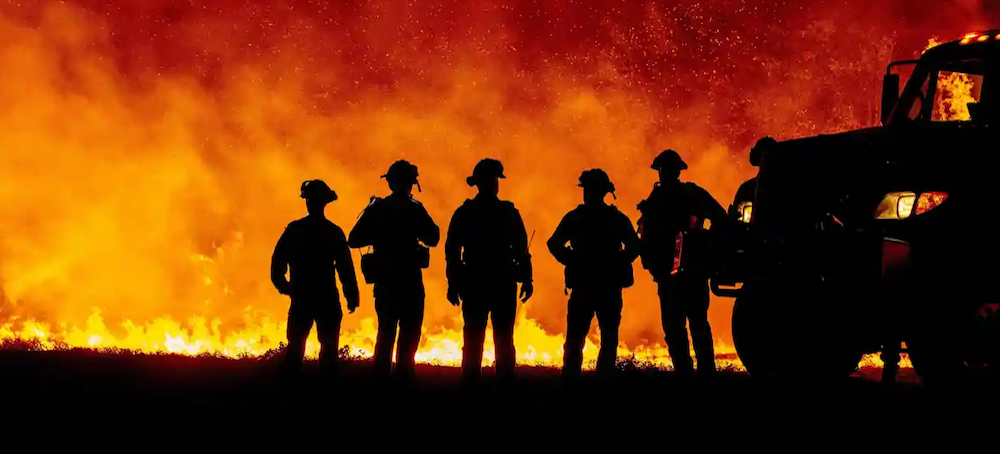Fast-Spreading Wildfire East of LA Forces Thousands to Flee Amid Fierce Heatwave
Oliver Milman and Dani Anguiano Guardian UK Firefighters tackle a wildfire in California. (photo: Josh Edelson/AFP/Getty Images)
Firefighters tackle a wildfire in California. (photo: Josh Edelson/AFP/Getty Images) Fast-Spreading Wildfire East of LA Forces Thousands to Flee Amid Fierce Heatwave
Oliver Milman and Dani Anguiano Guardian UK
California’s Line fire, only 3% contained, has charred more than 21,000 acres as temperatures soar into triple digits
In southern California, currently in the grip of a ferocious heatwave, the so-called Line fire has burned areas around San Bernardino national forest, about 65 miles (105km) east of Los Angeles.
As of Monday morning, the blaze had charred more than 23,000 acres of grass and chaparral and blanketed the area with a thick cloud of dark smoke.
Only 3% of it is contained, threatening more than 36,000 structures, including single- and multi-family homes and commercial buildings, the US Forest Service said.
In northern California, firefighters made progress in containing a small but fast-moving fire that ignited on Sunday and burned at least 30 homes and commercial buildings and destroyed 40 to 50 vehicles. The 76-acre Boyles fire, which was at least 40% contained on Monday morning, has displaced roughly 4,000 people around Clearlake.
Meanwhile, authorities across the state are bracing for more intense temperatures in a region that has already been rocked by days of searing heat that set the stage for fire conditions.
“We know that triple-digit temperatures are coming again today, so that’s why it’s so important to get that work done at night when it is cooler,” Cal Fire battalion chief Brent Pascua told CBS on Monday morning.
“We had the water-dropping helicopters back last night, so hopefully we’ll see that containment come up.”
The situation is worsened by thunderstorms that are providing winds fanning the flames, Cal Fire said, as well as the high temperatures, which have exceeded 110F (43C) in Los Angeles. Scientists have warned that persistent heatwaves, fuelled by the climate crisis, are helping cause larger and longer-burning fires in the US west.
The California fire burned so hot on Saturday that it created its own thunderstorm-like weather systems of pyroculumus clouds, which can create more challenging conditions such as gusty winds and lightning strikes, according to the National Weather Service.
Firefighters worked in steep terrain in temperatures above 100F (38C), limiting their ability to control the blaze, officials said. State firefighters said three firefighters had been injured.
Evacuations were ordered on Saturday evening for Running Springs, Arrowbear Lake, areas east of Highway 330 and other regions.
Steven Michael King, a resident of Running Springs, said he had planned to stay to fight the fire and help his neighbors until Sunday morning, when the fire escalated. He had prepped his house to prevent fire damage but decided to leave out of fear smoke could keep him from finding a way out later.
“It came down to, which is worse, being trapped or being in a shelter?” King said outside an evacuation center on Sunday. “When conditions changed, I had to make a quick decision, just a couple of packs and it all fits in a shopping cart.”
Joseph Escobedo said his family has lived in Angelus Oaks for about three years and has never had to evacuate for wildfire. His family, with three young children, was among the remaining few who had not left as of Sunday afternoon.
“It’s kind of frightening with the possibility of losing your home and losing everything we worked really hard for,” Escobedo said as his family packed up the essentials to leave. “It’s hard to leave and not be sure if you’re gonna be able to come back.”
The affected area is near small mountain towns in the San Bernardino national forest, where southern California residents ski in the winter and mountain bike in the summer. Running Springs is on the route to the popular ski resort of Big Bear.
Smoke already blanketed downtown San Bernardino, where Joe Franco, a worker at Noah’s Restaurant, said his friends in the surrounding evacuation zones were gearing up to leave at a moment’s notice.
“They’re just kind of hanging on tight and getting their stuff ready to move,” Franco said. ”Normally they’re here, but a lot of people are not coming today.”
Redlands unified school district cancelled Monday classes for roughly 20,000 students, and the governor, Gavin Newsom, proclaimed a state of emergency for San Bernardino county.
On Sunday, another blaze sparked amid searing heat in southern California’s Angeles national forest. The blaze burning north of the city of Glendora, in Los Angeles county, was 820 acres and uncontained on Monday.
The Los Angeles county sheriff’s department ordered visitors at a campground and residents of an adjacent river community to evacuate, the US Forest Service said.
Meanwhile, about 20 miles outside Reno, Nevada, the Davis fire, which started on Sunday afternoon, has grown to about 10 sq miles (26 sq km). It originated in the Davis Creek regional park in the Washoe Valley and was burning in heavy timber and brush, firefighters said. It, too, was not contained.
An emergency declaration issued for Washoe county by the Nevada governor, Joe Lombardo, on Sunday said about 20,000 people were evacuated from neighborhoods, businesses, parks and campgrounds. Some of south Reno remained under the evacuation notice on Monday, firefighters said, and some homes, businesses and traffic signals in the area were without power.
